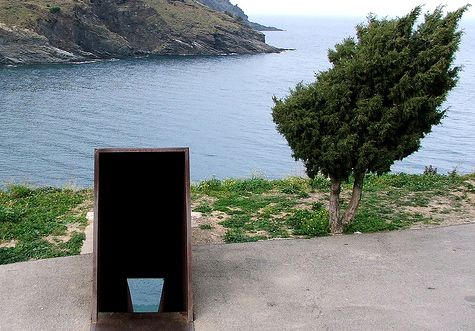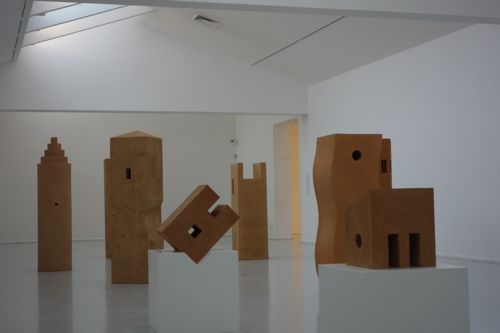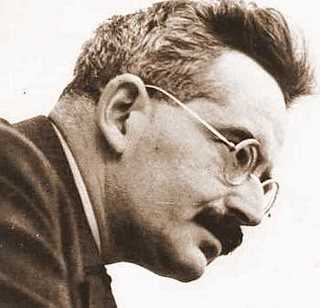14 March to 31 May 2015
Dani Karavan at Ceret
By Ellen Turner Hall

Dani Karavan is best known locally for his brushed steel Walter Benjamin memorial slicing through a cliff above the sea at Port Bou.
Benjamin, the German Jewish philosopher, seeking a passage to freedom in 1940, took his own life rather than face the threat of being sent back over the border to Nazi-occupied France .
 From 14 March to 31 May the museum of Ceret presents a retrospective of Karavan’s work. Starting with the memorial in Port Bou, with accompanying sketches and plans, the exhibition shows Karavan‘s monumental landscape sculptures all over the world, including current projects in France, Japan and Israel.
From 14 March to 31 May the museum of Ceret presents a retrospective of Karavan’s work. Starting with the memorial in Port Bou, with accompanying sketches and plans, the exhibition shows Karavan‘s monumental landscape sculptures all over the world, including current projects in France, Japan and Israel.
An introductory film about Karavan, entitled “Form and Place” points out the elements which link all of the artist’s creations: perspective, light, dark, earth, water, stone, trees, columns, steps, bridges.
Each of his projects tells a story to mark a historical moment. In the end he works within the paradox of “the life which death makes possible”, building something positive out of the horror that went before.
In one room wooden building blocks, paper and coloured pencils are available on a big table with the invitation to create your own forms. During my visit three children and one adult were engrossed in constructing their individual designs.

The exhibition ends with Karavan’s most recent works: clay tablets and earth-coloured chimney-like columns, forms at once ancient and modern, suggesting that history is always with us.
For further details: www.musee-ceret.com.
Walter Benjamin
Walter left his homeland as Hitler rose to power and by 1933 was living in Paris. As the Germans swept into France he fled south, first to Marseille then to Banyuls. There Lisa Fittko, also a Jew and Hans, her Protestant husband, met him. Their own flight from Nazi Germany in 1940 had been terrifying, landing them in separate concentration camps in occupied France. Escaping, they had also fled further and further south. In Banyuls they had joined the local guides helping refugees flee on the torturous paths over the mountains into Spain to Port Bou. From Puig del Mas, the old village of Banyuls where a monument honouring the Fittkos points to the distant Col, Walter Benjamin headed over the mountains to Spain, short of breath, bad heart, a heavy smoker, carrying a large briefcase in which was the manuscript of his last book. As you walk in his footsteps, remember man’s inhumanity to man, the courage of those who walked this path so often, helping desperate refugees to cross the border to relative safety, the bravery of the “evades”, and the cruelty that drove the refugees back and forth across the border. In the thirties the same route had been used in the opposite direction by Republicans fleeing Franco. In September 1940, Walter and the Fittkos reached Port Bou, and Benjamin learned that the Spanish government had cancelled all transit visas and ordered the Spanish police to return refugees to France Anticipating being handed over to the Nazis, and in utter despair, Benjamin took his own life. He was found dead the next day, in his room at the Hotel de Francia but it was never completely clear whether his death (apparently resulting from an overdose of morphine tablets), was suicide or murder. Ironically, his death certificate was accidentally signed as ‘Benjamin Walter’, so his Jewish origins were not obvious and he was buried in the actual cemetery instead of the area reserved for non-Catholics and unbelievers. Outside the town cemetery lies the Walter Benjamin memorial. A heavy metal passage containing a steep staircase sloped down to the sea breaking on the rocks below. On a pane of plate glass at the bottom of the staircase is written “It is more difficult to honour the memory of the nameless than that of the renowned. Historical construction is devoted to the memory of the nameless” |

 Walter Benjamin, (1892 – 1940) German-Jewish literary critic, fierce critic of Nazism and posthumously one of the twentieth century’s greatest philosophers, has a plaque dedicated to him in Banyuls-sur-Mer.(See link below)
Walter Benjamin, (1892 – 1940) German-Jewish literary critic, fierce critic of Nazism and posthumously one of the twentieth century’s greatest philosophers, has a plaque dedicated to him in Banyuls-sur-Mer.(See link below)